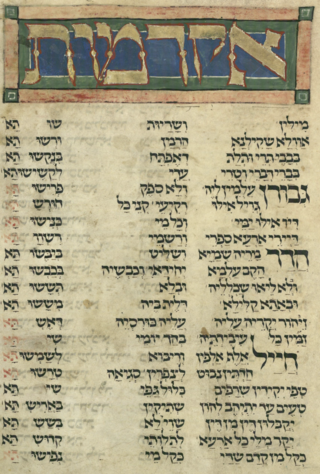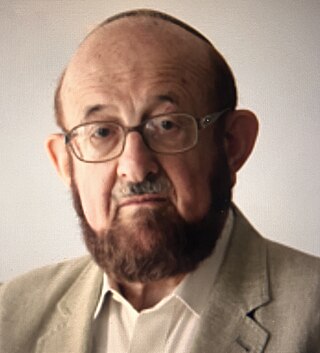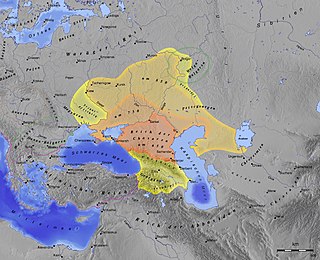
Yiddish is a West Germanic language historically spoken by Ashkenazi Jews. It originated in 9th century Central Europe, and provided the nascent Ashkenazi community with a vernacular based on High German fused with many elements taken from Hebrew and to some extent Aramaic. Most varieties of Yiddish include elements of Slavic languages and the vocabulary contains traces of Romance languages. Yiddish has traditionally been written using the Hebrew alphabet.

Ashkenazi Jews constitute a Jewish diaspora population that emerged in the Holy Roman Empire around the end of the first millennium CE. They traditionally speak Yiddish, a language that originated in the 9th century, and largely migrated towards northern and eastern Europe during the late Middle Ages due to persecution. Hebrew was primarily used as a literary and sacred language until its 20th-century revival as a common language in Israel.
Ashkenazi Hebrew is the pronunciation system for Biblical and Mishnaic Hebrew favored for Jewish liturgical use and Torah study by Ashkenazi Jewish practice.
The Hasidim of Ashkenaz were a Jewish mystical, ascetic movement in the German Rhineland during the 12th and 13th centuries.
In Judaism, Nusach is the exact text of a prayer service; sometimes the English word "rite" is used to refer to the same thing. Nusakh means "formulate" or "wording".
Av Harachamim or Abh Haraḥamim is a Jewish memorial prayer which was written in the late eleventh or early twelfth century, after the destruction of the Ashkenazi communities around the Rhine River by Christian crusaders during the First Crusade. First appearing in prayer books in 1290, it is printed in every Orthodox siddur in the European traditions of Nusach Sefarad and Nusach Ashkenaz and recited as part of the weekly Shabbat services, or in some communities on the Shabbat before Shavuot and Tisha B'Av.
Italian Jews or Roman Jews can be used in a broad sense to mean all Jews living in or with roots in Italy, or, in a narrower sense, to mean the Italkim, an ancient community living in Italy since the Ancient Roman era, who use the Italian liturgy as distinct from those Jewish communities in Italy dating from medieval or modern times who use the Sephardic liturgy or the Nusach Ashkenaz.

Akdamut, or Akdamus or Akdamut Milin, or Akdomus Milin, is a prominent piyyut written in Aramaic recited annually on the Jewish holiday of Shavuot by Ashkenazi Jews. It was penned by Rabbi Meir bar Yitzchak of Orléans, who was a cantor in Worms, Germany,. Akdamut consists of praise for God, His Torah, and His people.
Ashkenazi is a surname of Jewish origin. The term Ashkenaz refers to the area along the Rhine in Western Europe where diaspora Jews settled and formed communities during the Middle Ages.

Haym Soloveitchik is an American Modern Orthodox rabbi and historian. He is the only son of Rabbi Joseph B. Soloveitchik. He graduated from the Maimonides School which his father founded in Brookline, Massachusetts and then received his B.A. degree from Harvard College in 1958 with a major in History. After two years of post-graduate study at Harvard, he moved to Israel and began his studies toward an M.A. and PhD at the Hebrew University in Jerusalem, under the historian Professor Jacob Katz. He wrote his Master's thesis on the Halakha of gentile wine in medieval Germany. His doctorate, which he received in 1972, concentrated on laws of pawnbroking and usury. He is known to many as Dr. Gra"ch, after his great-grandfather for whom he is named, Rabbi Chaim Soloveitchik, who was known as the Gra"ch.

Ashkenaz in the Hebrew Bible is one of the descendants of Noah. Ashkenaz is the first son of Gomer, and a Japhetic patriarch in the Table of Nations. In rabbinic literature, the descendants of Ashkenaz were first associated with the Scythian cultures, then later with the Slavic territories, and, from the 11th century onwards, with Germany and northern Europe, or the Indo-European people, in a manner similar to Tzarfat or Sefarad.
Nusach Sefard, Nusach Sepharad, or Nusach Sfard is the name for various forms of the Jewish siddurim, designed to reconcile Ashkenazi customs with the kabbalistic customs of Isaac Luria. To this end it has incorporated the wording of Nusach Edot haMizrach, the prayer book of Sephardi Jews, into certain prayers. Nusach Sefard is used nearly universally by Hasidim, as well as by some other Ashkenazi Jews but has not gained significant acceptance by Sephardi Jews. Some Hasidic dynasties use their own version of the Nusach Sefard siddur, sometimes with notable divergence between different versions.
The Erfurt Treasure is a hoard of coins, goldsmiths' work and jewellery that is assumed to have belonged to a Jew of Erfurt, Germany who hid them in 1349 before perishing in the Erfurt massacre, one of the persecutions and massacres of Jews during the Black Death. The treasure was found in 1998 in the wall of a house in a medieval Jewish neighbourhood in Erfurt.
Nusach Ashkenaz is a style of Jewish liturgy conducted by Ashkenazi Jews. It is primarily a way to order and include prayers, and differs from Nusach Sefard and Baladi-rite prayer, and still more from the Sephardic rite proper, in the placement and presence of certain prayers.

The Eretz Israel minhag, as opposed to the Babylonian minhag, refers to the minhag of medieval Palestinian Jews concerning the siddur.

The Khazar hypothesis of Ashkenazi ancestry, often called the Khazar myth by its critics, is a largely abandoned historical hypothesis that postulated that Ashkenazi Jews were primarily, or to a large extent, descended from Khazars, a multi-ethnic conglomerate of mostly Turkic peoples who formed a semi-nomadic khanate in and around the northern and central Caucasus and the Pontic–Caspian steppe. The hypothesis also postulated that after collapse of the Khazar empire, the Khazars fled to Eastern Europe and made up a large part of the Jews there. The hypothesis draws on medieval sources such as the Khazar Correspondence, according to which at some point in the 8th–9th centuries, a small number of Khazars were said by Judah Halevi and Abraham ibn Daud to have converted to Rabbinic Judaism. The scope of the conversion within the Khazar Khanate remains uncertain, but the evidence used to tie the subsequent Ashkenazi communities to the Khazars is meager and subject to conflicting interpretations.

The expression Eastern European Jewry has two meanings. Its first meaning refers to the current political spheres of the Eastern European countries and its second meaning refers to the Jewish communities in Russia and Poland. The phrase 'Eastern European Jews' or 'Jews of the East' was established during the 20th century in the German Empire and in the western provinces of the Austro-Hungarian Empire, aiming to distinguish the integrating Jews in Central Europe from those Jews who lived in the East. This feature deals with the second meaning of the concept of Eastern European Jewry—the Jewish groups that lived in Poland, Ukraine, Belarus, Latvia, Lithuania, Estonia, Russia, Romania, Hungary and modern-day Moldova in collective settlement, many of whom spoke Yiddish.
Minhag Polin/Minhag Lita is the Ashkenazi minhag of the Polish Jews, the Polish/Lithuanian or Eastern branch of Nusach Ashkenaz, used in Eastern Europe, the United States and by some Israeli Ashkenazim, particularly those who identify as "Lithuanian". This is different from German or Western branch of Nusach Ashkenaz, known in Hebrew as "Minhag Ashkenaz", used in Western and Central Europe.
Isaac HaLevi Asir HaTikvah, also known as Isaac of Beilstein, was an important 14th-century Ashkenazi Rabbinic leader.
Minhag Ashkenaz is the minhag of the Ashkenazi German Jews. Minhag Ashkenaz was common in Germany, Austria, the Czech lands, and elsewhere in Western Europe, in contrast to the Minhag Polin of the Eastern European Ashkenazi Jews.







